tire type JEEP RENEGADE 2023 User Guide
[x] Cancel search | Manufacturer: JEEP, Model Year: 2023, Model line: RENEGADE, Model: JEEP RENEGADE 2023Pages: 364, PDF Size: 18.65 MB
Page 332 of 364
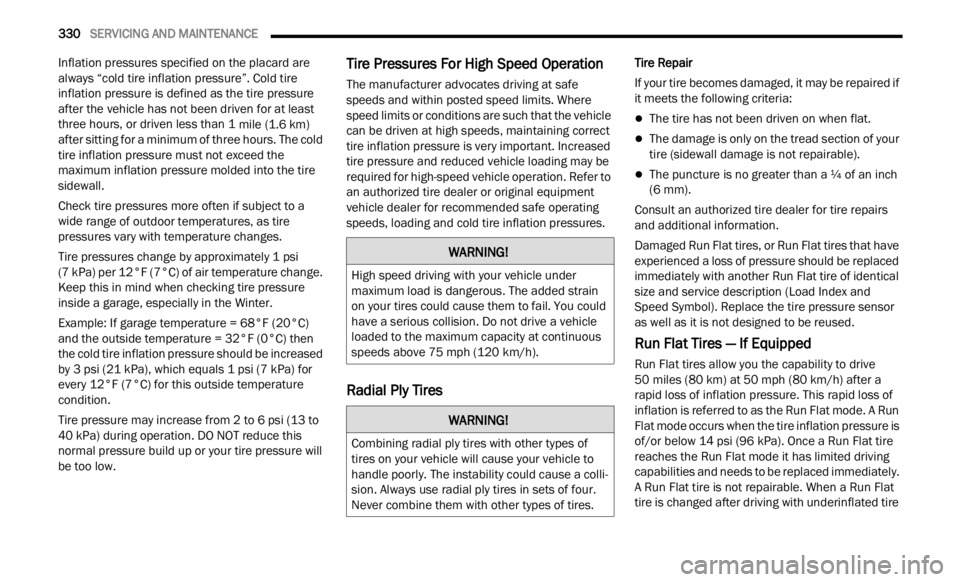
330 SERVICING AND MAINTENANCE
Inflation pressures specified on the placard are
always “cold tire inflation pressure”. Cold tire
inflation pressure is defined as the tire pressure
after the vehicle has not been driven for at least
three hours, or driven less than 1
mile (1.6 km)
after
sitting for a minimum of three hours. The cold
tire inflation pressure must not exceed the
maximum inflation pressure molded into the tire
sidewall.
Check tire pressures more often if subject to a
wide r
ange of outdoor temperatures, as tire
pressures vary with temperature changes.
Tire pressures change by approximately 1 psi
(7 kPa) per 12°F (7°C) of air temperature change.
K eep t
his in mind when checking tire pressure
inside a garage, especially in the Winter.
Example: If garage temperature = 68°F (20°C)
and t h
e outside temperature = 32°F (0°C) then
the cold tire inflation pressure should be increased
by 3 psi (21 kPa), which equals 1 psi (7 kPa) for
every 12°F (7°C) for this outside temperature
condition.
Tire pressure may increase from 2 to 6 psi (13 to
40 kPa
) during operation. DO NOT reduce this
normal pressure build up or your tire pressure will
be too low.
Tire Pressures For High Speed Operation
The manufacturer advocates driving at safe
speeds and within posted speed limits. Where
speed limits or conditions are such that the vehicle
can be driven at high speeds, maintaining correct
tire inflation pressure is very important. Increased
tire pressure and reduced vehicle loading may be
required for high-speed vehicle operation. Refer to
an authorized tire dealer or original equipment
vehicle dealer for recommended safe operating
speeds, loading and cold tire inflation pressures.
Radial Ply Tires
Tire Repair
If your tire becomes damaged, it may be repaired if
it me e
ts the following criteria:
The tire has not been driven on when flat.
The damage is only on the tread section of your
tire (sidewall damage is not repairable).
The puncture is no greater than a ¼ of an inch
(6 mm).
Consult an authorized tire dealer for tire repairs
a nd ad
ditional information.
Damaged Run Flat tires, or Run Flat tires that have
experi
enced a loss of pressure should be replaced
immediately with another Run Flat tire of identical
size and service description (Load Index and
Speed Symbol). Replace the tire pressure sensor
as well as it is not designed to be reused.
Run Flat Tires — If Equipped
Run Flat tires allow you the capability to drive
50 miles (80 km) at 50 mph (80 km/h) after a
r a
pi
d
loss of inflation pressure. This rapid loss of
inflation is referred to as the Run Flat mode. A Run
Flat mode occurs when the tire inflation pressure is
of/or below 14 psi (96 kPa). Once a Run Flat tire
reaches the Run Flat mode it has limited driving
capabilities and needs to be replaced immediately.
A Run Flat tire is not repairable. When a Run Flat
tire is changed after driving with underinflated tire
WARNING!
High speed driving with your vehicle under
maximum load is dangerous. The added strain
on your tires could cause them to fail. You could
have a serious collision. Do not drive a vehicle
loaded to the maximum capacity at continuous
speeds above 75 mph (120 km/h).
WARNING!
Combining radial ply tires with other types of
tires on your vehicle will cause your vehicle to
handle poorly. The instability could cause a colli
-
sion. Always use radial ply tires in sets of four.
Never
combine them with other types of tires.
Page 334 of 364
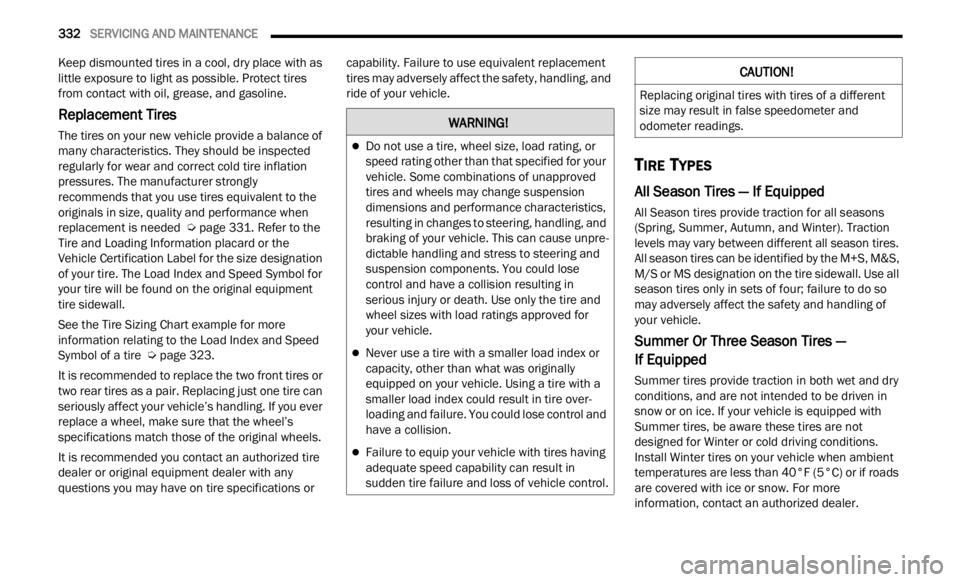
332 SERVICING AND MAINTENANCE
Keep dismounted tires in a cool, dry place with as
little exposure to light as possible. Protect tires
from contact with oil, grease, and gasoline.
Replacement Tires
The tires on your new vehicle provide a balance of
many characteristics. They should be inspected
regularly for wear and correct cold tire inflation
pressures. The manufacturer strongly
recommends that you use tires equivalent to the
originals in size, quality and performance when
replacement is needed
Ú page 331. Refer to the
Tire and Loading Information placard or the
Vehic l
e Certification Label for the size designation
of your tire. The Load Index and Speed Symbol for
your tire will be found on the original equipment
tire sidewall.
See the Tire Sizing Chart example for more
inform a
tion relating to the Load Index and Speed
Symbol of a tire Ú page 323.
It is recommended to replace the two front tires or
two re a
r tires as a pair. Replacing just one tire can
seriously affect your vehicle’s handling. If you ever
replace a wheel, make sure that the wheel’s
specifications match those of the original wheels.
It is recommended you contact an authorized tire
deale r
or original equipment dealer with any
questions you may have on tire specifications or capability. Failure to use equivalent replacement
tires may adversely affect the safety, handling, and
ride of your vehicle.
TIRE TYPES
All Season Tires — If Equipped
All Season tires provide traction for all seasons
(Spring, Summer, Autumn, and Winter). Traction
levels may vary between different all season tires.
All season tires can be identified by the M+S, M&S,
M/S or MS designation on the tire sidewall. Use all
season tires only in sets of four; failure to do so
may adversely affect the safety and handling of
your vehicle.
Summer Or Three Season Tires —
If Equipped
Summer tires provide traction in both wet and dry
conditions, and are not intended to be driven in
snow or on ice. If your vehicle is equipped with
Summer tires, be aware these tires are not
designed for Winter or cold driving conditions.
Install Winter tires on your vehicle when ambient
temperatures are less than 40°F (5°C) or if roads
are covered with ice or snow. For more
information, contact an authorized dealer.
WARNING!
Do not use a tire, wheel size, load rating, or
speed rating other than that specified for your
vehicle. Some combinations of unapproved
tires and wheels may change suspension
dimensions and performance characteristics,
resulting in changes to steering, handling, and
braking of your vehicle. This can cause unpre -
dictable handling and stress to steering and
suspe n
sion components. You could lose
control and have a collision resulting in
serious injury or death. Use only the tire and
wheel sizes with load ratings approved for
your vehicle.
Never use a tire with a smaller load index or
capacity, other than what was originally
equipped on your vehicle. Using a tire with a
smaller load index could result in tire over -
loading and failure. You could lose control and
h ave a
collision.
Failure to equip your vehicle with tires having
adequate speed capability can result in
sudden tire failure and loss of vehicle control.
CAUTION!
Replacing original tires with tires of a different
size may result in false speedometer and
odometer readings.
Page 335 of 364
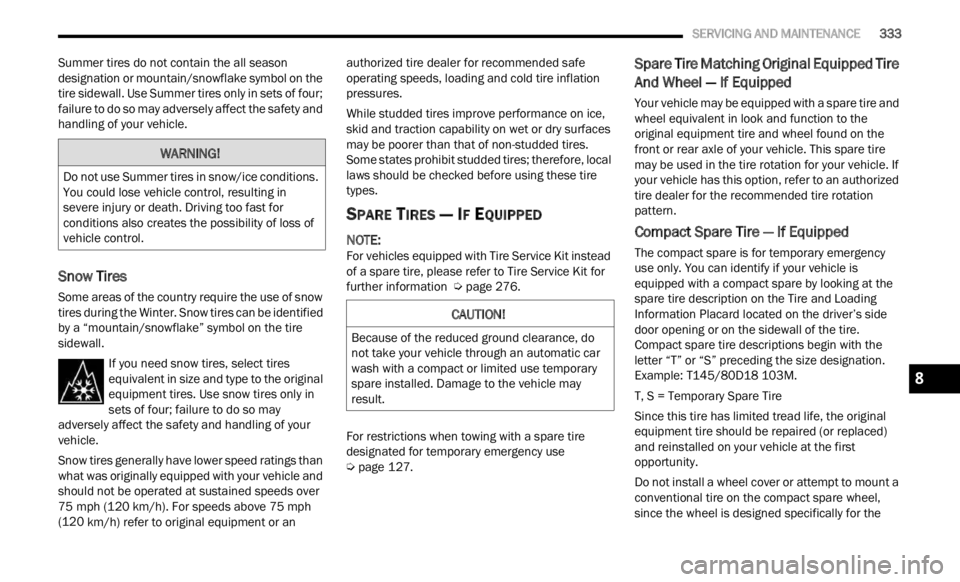
SERVICING AND MAINTENANCE 333
Summer tires do not contain the all season
designation or mountain/snowflake symbol on the
tire sidewall. Use Summer tires only in sets of four;
failure to do so may adversely affect the safety and
handling of your vehicle.
Snow Tires
Some areas of the country require the use of snow
tires during the Winter. Snow tires can be identified
by a “mountain/snowflake” symbol on the tire
sidewall.
If you need snow tires, select tires
equivalent in size and type to the original
equipm
ent tires. Use snow tires only in
sets of four; failure to do so may
adversely affect the safety and handling of your
vehicle.
Snow tires generally have lower speed ratings than
what w
as originally equipped with your vehicle and
should not be operated at sustained speeds over
75 mph (120 km/h). For speeds above 75 mph
(120 km
/h) refer to original equipment or an a
u
th
or i zed tire dealer for recommended safe
operating speeds, loading and cold tire inflation
pressures.
While studded tires improve performance on ice,
skid a
nd traction capability on wet or dry surfaces
may be poorer than that of non-studded tires.
Some states prohibit studded tires; therefore, local
laws should be checked before using these tire
types.
SPARE TIRES — IF EQUIPPED
NOTE:
For vehicles equipped with Tire Service Kit instead
of a s p
are tire, please refer to Tire Service Kit for
further information Ú page 276.
For restrictions when towing with a spare tire
desig n
ated for temporary emergency use
Ú page 127.
Spare Tire Matching Original Equipped Tire
And Wheel — If Equipped
Your vehicle may be equipped with a spare tire and
wheel equivalent in look and function to the
original equipment tire and wheel found on the
front or rear axle of your vehicle. This spare tire
may be used in the tire rotation for your vehicle. If
your vehicle has this option, refer to an authorized
tire dealer for the recommended tire rotation
pattern.
Compact Spare Tire — If Equipped
The compact spare is for temporary emergency
use only. You can identify if your vehicle is
equipped with a compact spare by looking at the
spare tire description on the Tire and Loading
Information Placard located on the driver’s side
door opening or on the sidewall of the tire.
Compact spare tire descriptions begin with the
letter “T” or “S” preceding the size designation.
Example: T145/80D18 103M.
T, S = Temporary Spare Tire
Since this tire has limited tread life, the original
e
quip m
ent tire should be repaired (or replaced)
and reinstalled on your vehicle at the first
opportunity.
Do not install a wheel cover or attempt to mount a
convent
ional tire on the compact spare wheel,
since the wheel is designed specifically for the
WARNING!
Do not use Summer tires in snow/ice conditions.
You could lose vehicle control, resulting in
severe injury or death. Driving too fast for
conditions also creates the possibility of loss of
vehicle control.
CAUTION!
Because of the reduced ground clearance, do
not take your vehicle through an automatic car
wash with a compact or limited use temporary
spare installed. Damage to the vehicle may
result.
8
Page 338 of 364
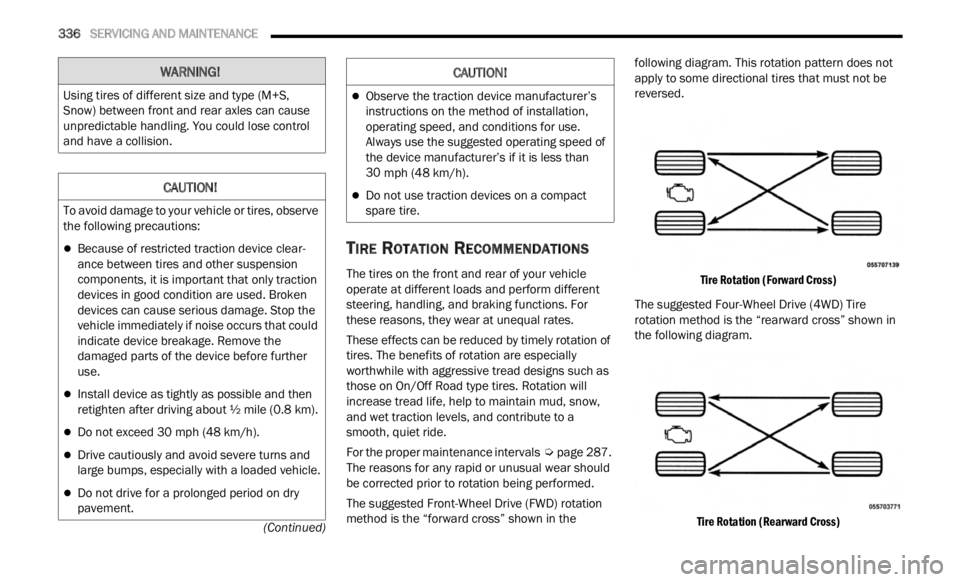
336 SERVICING AND MAINTENANCE
(Continued)
TIRE ROTATION RECOMMENDATIONS
The tires on the front and rear of your vehicle
operate at different loads and perform different
steering, handling, and braking functions. For
these reasons, they wear at unequal rates.
These effects can be reduced by timely rotation of
tires.
The benefits of rotation are especially
worthwhile with aggressive tread designs such as
those on On/Off Road type tires. Rotation will
increase tread life, help to maintain mud, snow,
and wet traction levels, and contribute to a
smooth, quiet ride.
For the proper maintenance intervals Ú page 287.
The reasons for any rapid or unusual wear should
b e cor r
ected prior to rotation being performed.
The suggested Front-Wheel Drive (FWD) rotation
method
is the “forward cross” shown in the following diagram. This rotation pattern does not
apply to some directional tires that must not be
reversed.
Tire Rotation (Forward Cross)
The suggested Four-Wheel Drive (4WD) Tire
rotati on
method is the “rearward cross” shown in
the following diagram.
Tire Rotation (Rearward Cross)
WARNING!
Using tires of different size and type (M+S,
Snow) between front and rear axles can cause
unpredictable handling. You could lose control
and have a collision.
CAUTION!
To avoid damage to your vehicle or tires, observe
the following precautions:
Because of restricted traction device clear -
ance between tires and other suspension
compone n
ts, it is important that only traction
devices in good condition are used. Broken
devices can cause serious damage. Stop the
vehicle immediately if noise occurs that could
indicate device breakage. Remove the
damaged parts of the device before further
use.
Install device as tightly as possible and then
retighten after driving about ½ mile (0.8 km).
Do not exceed 30 mph (48 km/h).
Drive cautiously and avoid severe turns and
large bumps, especially with a loaded vehicle.
Do not drive for a prolonged period on dry
pavement.
Observe the traction device manufacturer’s
instructions on the method of installation,
operating speed, and conditions for use.
Always use the suggested operating speed of
the device manufacturer’s if it is less than
30
mph (48 km/h).
Do not use traction devices on a compact
spare tire.
CAUTION!
Page 339 of 364
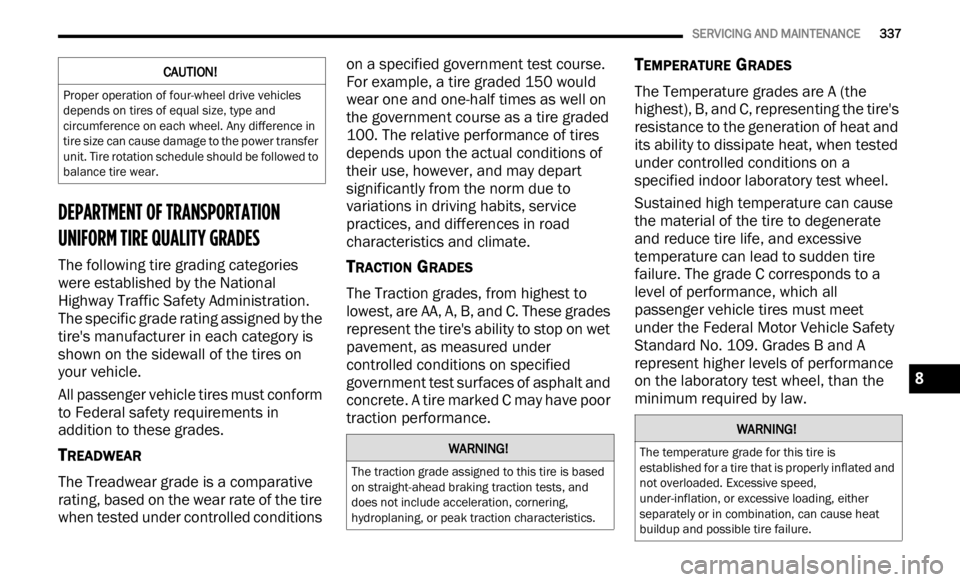
SERVICING AND MAINTENANCE 337
DEPARTMENT OF TRANSPORTATION
UNIFORM TIRE QUALITY GRADES
The following tire grading categories
were established by the National
Highway Traffic Safety Administration.
The specific grade rating assigned by the
tire's manufacturer in each category is
shown on the sidewall of the tires on
your vehicle.
All passenger vehicle tires must conform
to Fede
ral safety requirements in
addition to these grades.
TREADWEAR
The Treadwear grade is a comparative
rating, based on the wear rate of the tire
when tested under controlled conditions on a specified government test course.
For example, a tire graded 150 would
wear one and one-half times as well on
the government course as a tire graded
100. The relative performance of tires
depends upon the actual conditions of
their use, however, and may depart
significantly from the norm due to
variations in driving habits, service
practices, and differences in road
characteristics and climate.
TRACTION GRADES
The Traction grades, from highest to
lowest, are AA, A, B, and C. These grades
represent the tire's ability to stop on wet
pavement, as measured under
controlled conditions on specified
government test surfaces of asphalt and
concrete. A tire marked C may have poor
traction performance.
TEMPERATURE GRADES
The Temperature grades are A (the
highest), B, and C, representing the tire's
resistance to the generation of heat and
its ability to dissipate heat, when tested
under controlled conditions on a
specified indoor laboratory test wheel.
Sustained high temperature can cause
the ma
terial of the tire to degenerate
and reduce tire life, and excessive
temperature can lead to sudden tire
failure. The grade C corresponds to a
level of performance, which all
passenger vehicle tires must meet
under the Federal Motor Vehicle Safety
Standard No. 109. Grades B and A
represent higher levels of performance
on the laboratory test wheel, than the
minimum required by law.
CAUTION!
Proper operation of four-wheel drive vehicles
depends on tires of equal size, type and
circumference on each wheel. Any difference in
tire size can cause damage to the power transfer
unit. Tire rotation schedule should be followed to
balance tire wear.
WARNING!
The traction grade assigned to this tire is based
on straight-ahead braking traction tests, and
does not include acceleration, cornering,
hydroplaning, or peak traction characteristics.
WARNING!
The temperature grade for this tire is
established for a tire that is properly inflated and
not overloaded. Excessive speed,
under-inflation, or excessive loading, either
separately or in combination, can cause heat
buildup and possible tire failure.
8
Page 353 of 364

351
INDEX
A
About Your Brakes.........................................341Adding Engine Coolant (Antifreeze)...............300Adding Fuel....................................................122Adding Washing Fluid....................................294Additives, Fuel...............................................343Advance Phone Connectivity.........................172Air Bag...........................................................247Advance Front Air Bag...............................247Air Bag Operation......................................248Air Bag Warning Light................................246Driver Knee Air Bag...................................249Enhanced Accident Response.........252, 285Event Data Recorder (EDR).......................285Front Air Bag.............................................247If Deployment Occurs................................252Knee Impact Bolsters................................249Maintaining Your Air Bag System..............255Maintenance.............................................255Redundant Air Bag Warning Light.............247Side Air Bags.............................................249Transporting Pets......................................265Air Bag Light..................................70, 246, 265Air Cleaner, Engine (Engine Air Cleaner
Filter).............................................................296Air Conditioner Maintenance.........................296
Air Conditioner Refrigerant..................296, 297Air Conditioning.............................................297Air Conditioning Filter..............................48, 297Air Conditioning System................................296Air Conditioning, Operating Tips.......................47Air Pressure Tires.........................................................329AlarmArm The System..........................................20Disarm The System.....................................21Security Alarm......................................20, 72Alterations/ModificationsVehicle.........................................................10Android Auto........................................174, 176Android Auto™
S
.......................................174Antifreeze (Engine Coolant).................300, 344Disposal...................................................301Anti-Lock Brake System (ABS)......................221Anti-Lock Warning Light............................72, 76Apple CarPlay.......................................174, 178Apple CarPlay®
S
......................................176Assist, Hill Start.............................................227Audio Settings...............................................160Audio Systems (Radio)..................................133Auto Down Power Windows.............................53Auto Up Power Windows..................................53
Automatic Headlights.......................................38Automatic High Beams.....................................37Automatic Temperature Control (ATC)..............47Automatic Transmission.........................85, 303Adding Fluid.....................................303, 345Autostick......................................................87Fluid And Filter Change.............................303Fluid Change.............................................303Fluid Level Check......................................303Fluid Type........................................303, 345Special Additives......................................303Auxiliary Electrical Outlet (Power Outlet)..........50Auxiliary Power Outlet......................................50Axle Fluid.......................................................345Axle Lubrication............................................345
B
Back-Up Camera...........................................121Battery...................................................70, 294Charging System Light.................................70Keyless Key Fob Replacement....................15Belts, Seat....................................................265Blind Spot Monitoring...................................228BluetoothConnecting To A Particular Mobile Phone
Or Audio Device After Pairing
................168
11
Page 359 of 364

357
R
Radial Ply Tires..............................................330Radiator Cap (Coolant Pressure Cap)............301RadioPresets......................................................160Radio Controls...............................................151Radio Mode...................................................151Radio Operation..................................151, 220Radio Remote Controls..................................150Rain Sensitive Wiper System...........................42Rear Camera.................................................121Rear Cross Path.............................................230Rear ParkSense System................................105Rear Window Defroster...................................43Rear Wiper/Washer.........................................43Rearview Mirror...............................................34Reclining Front Seats......................................27Recreational Towing......................................129Reformulated Gasoline..................................342Refrigerant....................................................297Registering SiriusXM Guardian......................203Reminder, Lights On........................................38Reminder, Seat Belt......................................241Remote ControlStarting System...........................................18Remote Features, Door Lock/Unlock..208, 215Remote Features, Horn And Lights................210Remote Features, Starting..................209, 217
Remote Keyless Entry......................................14Arm The Alarm.............................................20Disarm The Alarm........................................21Keyless Enter-N-Go......................................22Programming Additional Key Fobs...............16Remote Sound System (Radio) Control.........150Remote StartingUconnect Customer Programmable
Features
..................................................19Uconnect Settings.......................................19Remote Starting System..................................18Replacement Tires........................................332Reporting Safety Defects..............................348Restraints, Child...........................................255Restraints, Head..............................................31Roadside Assistance............................210, 216Roll Over Warning..............................................9Roof Type Carrier.............................................61Rotation, Tires..............................................336
S
Safety...........................................................149Safety Checks Inside Vehicle........................265Safety Checks Outside Vehicle.....................267Safety Defects, Reporting.............................348Safety Features.............................................149Safety Information, Tire................................322Safety Tips....................................................265
Safety, Exhaust Gas......................................267Satellite Radio...............................................155Saved Radio Stations....................................160Schedule, Maintenance................................286Seat Belt Reminder..........................................72Seat Belts............................................241, 265Adjustable Upper Shoulder Anchorage.....244Adjustable Upper Shoulder Belt
Anchorage............................................244Automatic Locking Retractor (ALR)...........245Child Restraints........................................255Energy Management Feature...................245Front Seat........................................241, 243Inspection.................................................265Lap/Shoulder Belt Operation....................243Lap/Shoulder Belt Untwisting...................244Lap/Shoulder Belts...................................241Operating Instructions..............................243Pregnant Women......................................245Pretensioners...........................................245Rear Seat..................................................241Reminder..................................................241Seat Belt Pretensioner..............................245Seat Belt Reminder..................................241Untwisting Procedure................................244Seat Belts Maintenance................................339
11